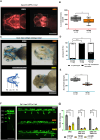TFAP2E is implicated in central nervous system, orofacial and maxillofacial anomalies
- PMID: 39715634
- PMCID: PMC11777392
- DOI: 10.1136/jmg-2023-109799
TFAP2E is implicated in central nervous system, orofacial and maxillofacial anomalies
Abstract
Background: Previous studies in mouse, Xenopus and zebrafish embryos show strong tfap2e expression in progenitor cells of neuronal and neural crest tissues suggesting its involvement in neural crest specification. However, the role of human transcription factor activator protein 2 (TFAP2E) in human embryonic central nervous system (CNS), orofacial and maxillofacial development is unknown.
Methods: Through a collaborative work, exome survey was performed in families with congenital CNS, orofacial and maxillofacial anomalies. Exome variant prioritisation prompted TFAP2E gene for functional analysis in zebrafish embryos. Embryonic morphology and development were assessed after antisense morpholino (MO) knockdown (KD), CRISPR/Cas9 knockout and overexpression of tfap2e in fluorescent zebrafish reporter lines using in vivo microscopy. Computational structural protein modelling of the identified human variants was performed.
Results: In total, exome survey identified novel or ultra-rare heterozygous missense variants in TFAP2E in seven individuals from five independent families with predominantly CNS, orofacial and maxillofacial anomalies. One variant was found de novo and another variant segregated in an affected multiplex family. Protein modelling of the identified variants indicated potential distortion of TFAP2E in the transactivation or dimerisation domain. MO KD and CRISPR/Cas9 knockout of tfap2e in zebrafish revealed hydrocephalus and a significant reduction of brain volume, consistent with a microencephaly phenotype. Furthermore, mRNA overexpression of TFAP2E indicates dosage-sensitive phenotype expression. In addition, zebrafish showed orofacial and maxillofacial anomalies following tfap2e KD, recapitulating the human phenotype.
Conclusion: Our human genetic data and analysis of Tfap2e manipulation in zebrafish indicate a potential role of TFAP2E in human CNS, orofacial and maxillofacial anomalies.
Keywords: Central Nervous System Diseases; Genetic Diseases, Inborn; Hydrocephalus; Whole Exome Sequencing.
© Author(s) (or their employer(s)) 2025. Re-use permitted under CC BY. Published by BMJ Group.
Conflict of interest statement
Competing interests: JRL has stock ownership in 23andMe, and is a member of the Scientific Advisory Board of Genome International, and an expert witness for Hawley-Troxell, and is a co-inventor on multiple US and European patents related to molecular diagnostics for inherited neuropathies, eye diseases and bacterial genomic fingerprinting. The Department of Molecular and Human Genetics at Baylor College of Medicine derives revenue from the chromosomal microarray analysis (CMA) and clinical exome sequencing offered at Baylor Genetics. All other authors declare no conflicts of interest.
Figures




References
MeSH terms
Substances
Grants and funding
LinkOut - more resources
Full Text Sources
Molecular Biology Databases
